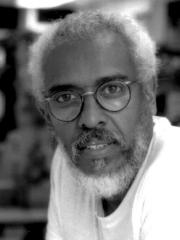
St. George
John T. Scott
- 1992
- Offset Lithograph
- Image/sheet: 19.87 x 14.87"
- 74 prints in this edition
About the Print
John T. Scott’s works display themes of African American life, Afro-Caribbean culture, and the music culture of his hometown—New Orleans. His work is best known for its unconventional and experimental use of materials. Scott used tools such as chain saws, spoons, traditional wood carving tools, kitchen knives, and various other accessible tools to create his prints.
—From Brandywine Workshop and Archives records
“In the African American community, he was the first to be embraced by the white world. He was an artist of prominence that could rival anyone in the city. He became the role model, the pinnacle that all of us strove to be like.” —artist Willie Birch on John T. Scott
—From Brandywine Workshop and Archives records
“In the African-American community, he was the first to be embraced by the white world. He was an artist of prominence that could rival anyone in the city. He became the role model, the pinnacle that all of us strove to be like.” — artist Willie Birch, on John T. Scott
About the Artist
John T. Scott was a sculptor, painter, printmaker, and collagist born in New Orleans, LA. He earned a BA at Xavier University of Louisiana, New Orleans, and an MFA from Michigan State University, East Lansing, where he studied under painter Charles Pollock. He taught at Xavier University for 40 years.
His works are in the permanent collections of the Ogden Museum of Southern Art, Amistad Research Center at Tulane University, Xavier University of Louisiana Art Collections and Gallery, Loyola University, and Louisiana Endowment for the Humanities, all in New Orleans; Louisiana State University’s Shaw Center for the Arts, Baton Rouge; Museum of Fine Arts, Houston, TX; Scripps College, Claremont, CA; Smithsonian American Art Museum, Washington, DC; Fisk University, Nashville, TN; and Baltimore Museum of Art, MD.
Among awards and honors received by Scott are a grant to study under sculptor George Rickey; an honorary Doctor of Humanities from Michigan State University; an honorary Doctor of Humanities from Tulane University, New Orleans; and a MacArthur Fellowship (“Genius Grant”) from the John D. and Catherine T. MacArthur Foundation.
—From Brandywine Workshop and Archives records
Curriculum Connections
Suggested Topics for Expressive Writing
Expressive Writing
The writings of Haki R. Madhubuti reflect a similar way of stereotyping as the word-prints of Edgar Heap of Birds. People of African descent are disproportionately represented in entertainment—as dancers and singers, particularly—and in professional sports. They are perceived as physically strong and fast. In American society, Blacks may entertain, play sports — or cook and clean. Outside of those realms, however, Blacks both with and without advanced education, social prominence, and financial success are considered dangerous, therefore representing a threatening presence at both ends of the socioeconomic spectrum.
Our abilities as viewers to understand the messages and connections that the artists hope their imagery will convey is largely based on the extent of our own experiences and information that we bring to viewing and interpreting the artwork. In many countries, these types of messages are not brought to broad public attention and are often considered subversive.
Questions to Consider
- Why are some people considered a threat while others are not?
- Why is there education inequality in most developed countries?
- Who benefits from stereotyping others?
Related Media
- “America Calling” by Haki R. Madhubuti (Don L. Lee)
- “AWARENESS” by Haki R. Madhubuti (Don L. Lee)
- “Middle Passage” by Robert Hayden
- Amistad (1997 film) directed by Steven Spielberg
- Just Mercy (2019 film) directed and written by Destin Daniel Cretton
- King in the Wilderness (2018 documentary) directed by Peter W. Kunhardt
- Committed to Memory: The Art of the Slave Ship Icon by Cheryl Finley, PhD (2018)
